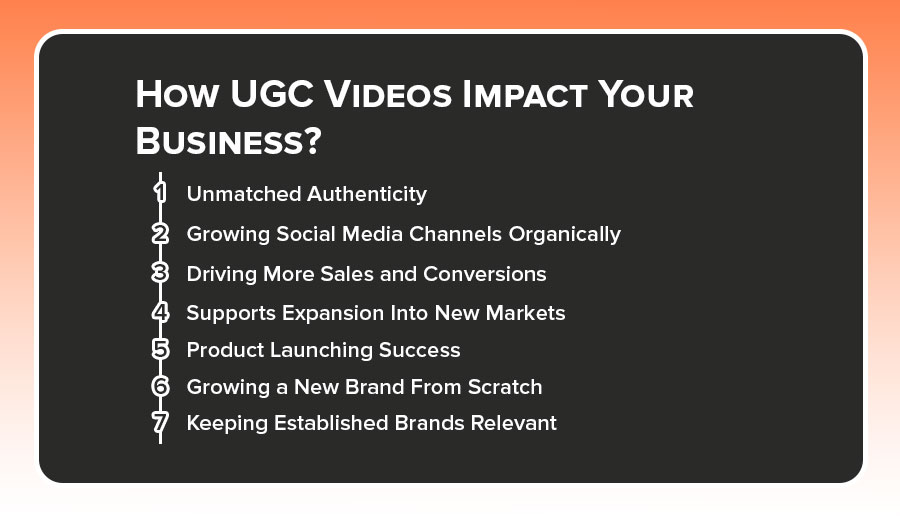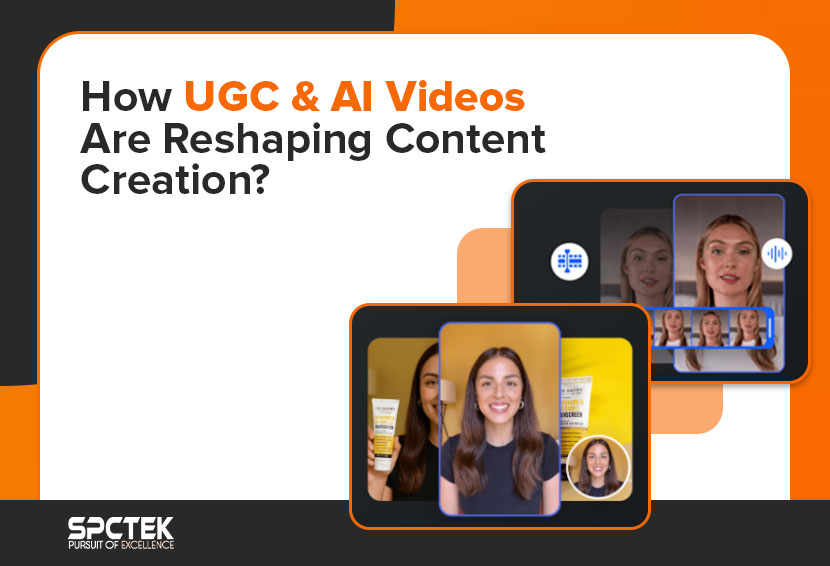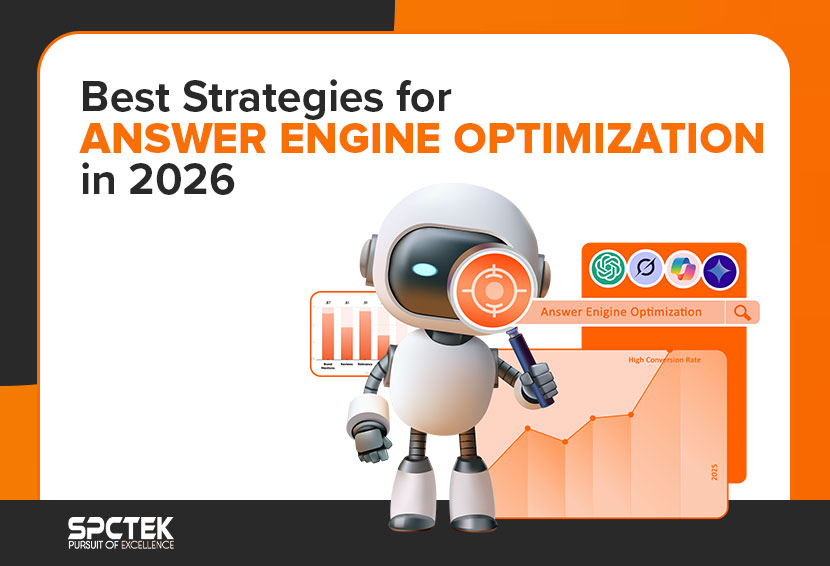Too busy to read? Listen to the article instead.
The world of digital marketing is changing fast. Today, brands don’t just rely on polished ads or celebrity endorsements; they’re turning to UGC and AI videos to tell real, relatable stories. This shift reflects a bigger movement in content creation evolution, where authenticity and technology now work hand in hand.
The rise of UGC and AI in content creation has opened new possibilities for brands to produce high-quality videos quickly and at scale, from realistic AI avatars to personalized product reviews. These innovations are part of the growing wave of user-and AI-generated video trends that are reshaping how audiences connect with brands online.
At the same time, UGC marketing, powered by everyday creators and UGC influencers, has proven that authentic storytelling builds stronger trust and engagement than traditional ads. This blog post helps you understand what UGC is, the types of UGC, and how it impacts your business. It also highlights current UGC trends, how to gather UGC, and how to use AI tools to create authentic UGC videos.
What is User Generated Content (UGC)?

User-generated content (UGC), also known as consumer-generated content, is original, brand-related material created by real customers or users. This type of content often appears across multiple platforms, from a company’s own website and social channels to third-party platforms such as review sites, YouTube, or TikTok.
UGC comes in many forms, including photos, short videos, testimonials, detailed product reviews, or even podcasts. These pieces of content often reflect genuine experiences and opinions, making them a powerful part of modern UGC marketing strategies.
How Does User-Generated Content Work?
User-generated content (UGC) works by turning real people, customers, employees, and creators (even AI) into brand storytellers. In UGC marketing, brands encourage users or UGC influencers to create and share authentic posts, photos, or videos that showcase products in real-life settings.
This builds trust and drives engagement because audiences relate more to genuine experiences than branded ads. Current UGC influencer content trends focus on short-form, relatable videos that feel native to platforms like TikTok and Instagram. With the rise of AI videos and UGC influencers, creators can now use AI tools to enhance their content by generating scripts, editing clips, or even producing realistic AI avatars.
4 Types of User-Generated Content (UGC)

When most people think of user-generated content (UGC), they picture happy customers sharing reviews, photos, or videos about a brand’s products. But UGC includes any content about your brand that isn’t created by the brand itself.
UGC can come from three main groups: customers, employees, and creators. Recently, a new form has emerged: AI-generated UGC content.
1. Customer-Generated Content
Your customers are your best promoters. When real people share their honest opinions or experiences, it builds trust and attracts new buyers.
Customer-generated UGC trends can include:
- Product reviews and star ratings
- Unboxing videos with your branded hashtag
- Customer videos featured on your website
- Q&A sections or online forums where customers help each other
2. Employee-Generated Content
Your team can also be a great source of authentic content. When employees share their experiences, it shows your company’s culture and values in a genuine way.
This kind of content can include:
- Videos from team events with branded hashtags
- Employees sharing company milestones or news
- LinkedIn posts from new hires celebrating their roles
3. Creator-Generated Content
UGC Creators and influencers help brands reach larger audiences through their own channels. This type of UGC is usually paid, and sometimes brands send free products or pay creators to share reviews or tutorials. But content created by UGC influencers and creators differs from traditional influencer marketing in its style, which feels more organic and authentic, as if created by a customer.
UGC influencer trends can include:
- An Instagram UGC influencer posting a video of your product
- Short-form videos on Instagram or TikTok about your product from small creators
- “Day in the life” and lifestyle vlogs showing products in daily use
- Unboxing and haul videos showing initial excitement on receiving the product
4. AI-Generated Content
AI-generated UGC looks and feels like real user posts but is created with artificial intelligence tools instead of human creators. Brands use AI in content creation to quickly produce realistic videos, voiceovers, and even AI avatars that talk about their products.
AI in content creation helps companies make authentic-looking ads or social media posts at scale, with faster speed and for less money. It also lets marketers test multiple UGC ad versions to see what works best, while still keeping that relatable, “human” touch. As AI-generated video trends grow on platforms like TikTok and Instagram, this approach is becoming a powerful new way for brands to stay creative and efficient.
How to Gather UGC Videos That Strengthen Your Brand?
If your audience isn’t naturally posting yet, you can encourage participation by finding the balance between what your customers love creating and what aligns with your marketing goals. You can use strategies like offering incentives and rewards, creating branded hashtags, using post-purchase touchpoints for encouragement, and taking the services of UGC creators or influencers.
1. Create a Branded Hashtag
A branded hashtag is one of the simplest and most effective ways to encourage and collect user-generated content, especially on visual platforms like Instagram, TikTok, X (formerly Twitter), and LinkedIn.
For example, the #crumblcookieoftheweek hashtag is created by Crumbl to give customers a dedicated space on social media to share the weekly rotating menu of Crumbl Cookies.

Branded hashtags also simplify content management. You can quickly find UGC submissions to:
- Repost on your social channels or Stories
- Add to your Instagram Shop listings
- Embed in your Shopify store as a carousel of social proof
With the rise of UGC influencers, hashtags have become a central part of UGC influencer content trends, allowing both brands and creators to connect through shared storytelling.
2. Encourage Participation With Contests and Giveaways
Contests and giveaways not only build awareness but also motivate users to create and share content about your brand.
For instance, a simple video contest that fits a specific theme can crowdsource a variety of visuals for your next campaign. Brands like Kai Collective incentivize UGC by rewarding customers who share unboxing videos of their KAI Sale orders and tag @kaicollective with cash gift cards equal to the full order value.

Source: Kai Collectives Instagram
These campaigns can:
- Grow organic reach through participant shares
- Generate valuable UGC for reuse in ads or social posts
- Reward loyal customers with prizes or discounts
You can manage contests manually through hashtags or streamline them using giveaway tools that track entries. You can also prompt creators to share videos and allow extra points for posting across multiple platforms.
3. Ask for UGC in Post-Purchase Touchpoints
Post-purchase communication is one of the best times to request content from customers. When someone has just received their order and is excited about it, they’re more likely to share their experience.
You can ask for UGC creation through:
- Automated post-purchase emails with calls to share videos
- Loyalty programs that reward users for video testimonials
- Packaging inserts with instructions on how to tag your brand or use your hashtag

4. AI videos and UGC influencers
AI videos and UGC influencers or creators have become an important part of modern UGC marketing. UGC creators produce content that feels natural and unscripted, much like a customer recommendation rather than a paid ad.
There is a growing trend of UGC influencer content due to the demand for such content. The UGC influencers’ impact comes from their authenticity and audience trust. The audience often views their content as genuine product experiences rather than brand endorsements.
AI UGC content creation is also gaining traction for being a feasible way for brands to create and scale UGC. AI UGC video platforms like Creatify, Synthesia, Invideo AI, and HeyGen allow brands to create realistic UGC videos and images.
5. Explore Paid UGC Platforms

Source: Influee
If you want to work with creators at scale, there are now dedicated platforms for paid UGC collaborations, such as Influee, Social Native, Billo, Cameo, and various creator platforms.
Paid UGC might sound contradictory, but many creators are happy to partner with brands they genuinely like. Their authenticity remains undamaged as long as the collaboration feels aligned with their values.
These platforms make it easier to find creators, negotiate rates, and streamline submissions. Combined with AI in content creation, they allow brands to amplify UGC campaigns faster than ever while preserving a human, relatable touch.
How UGC Videos Impact Your Business?

The UGC’s impact goes far beyond short-term promotions; it’s about delivering authentic, relatable content that connects with real audiences. UGC videos are considered to be highly authentic and believable by the audience, and this authenticity has become one of the most valuable tools in digital marketing.
The rise of UGC has encouraged brands to get their customers involved in creating and sharing content. It has also led to an increase in content trends driven by UGC influencers who build their following by creating authentic, user-like content. UGC can impact your business in the following ways:
1. Unmatched Authenticity
The sense of authenticity created by UGC is enormously greater than that of influencer-created content or branded content. A Stackla study found that 79% of people say user-generated content (UGC) strongly influences their buying choices. But only 13% feel the same about brand-created content, and just 8% about influencer content.
Growing Social Media Channels Organically: One of the biggest advantages of UGC marketing is its ability to grow your online presence organically. Content from UGC creators performs better than typical branded visuals because it feels authentic and community-driven.
Statistics show the power of this approach:
- UGC drives 28% higher engagement compared to traditional branded content.
- Social campaigns with UGC witness a 50% increase in engagement.
- UGC ads on social media attract 73% more positive comments.
To maximize reach, repurpose UGC across multiple channels: include it in paid ad campaigns, showcase it on product pages, highlight it in email newsletters, and share it as organic posts on your social platforms. This keeps your message consistent while leveraging the UGC influencer content trends that audiences already respond to.
2. Growing Social Media Channels Organically
One of the biggest advantages of UGC marketing is its ability to grow your online presence organically. Content from UGC creators performs better than typical branded visuals because it feels authentic and community-driven.
Statistics show the power of this approach:
- UGC drives 28% higher engagement compared to traditional branded content.
- Social campaigns with UGC witness a 50% increase in engagement.
- UGC ads on social media attract 73% more positive comments.
To maximize reach, repurpose UGC across multiple channels: include it in paid ad campaigns, showcase it on product pages, highlight it in email newsletters, and share it as organic posts on your social platforms. This keeps your message consistent while leveraging the UGC influencer content trends that audiences already respond to.
3. Driving More Sales and Conversions
Because it feels real and trustworthy, UGC drives conversions more effectively than traditional marketing. According to Shopify, ads that feature authentic UGC generate 4X higher click-through rates than standard branded ads.
This success is because viewers perceive their recommendations as genuine experiences rather than sales tactics. That emotional connection encourages people to act, turning engagement into measurable sales growth.
4. Supports Expansion Into New Markets
When entering a new region, understanding local culture, language, and preferences can be difficult. Collaborating with local UGC influencers gives you instant insight into what resonates with that audience.
These creators already understand what kind of visuals, tone, and storytelling appeal to their communities. By partnering with them or through UGC marketing platforms that connect you with international creators, you can quickly produce region-specific content that feels native and trustworthy from the start.
This localized approach not only saves time but also ensures that your brand feels authentic in every market you enter.
5. Product Launching Success
Launching a new product successfully often depends on how well you create excitement and trust. UGC creators can help by producing how-to videos, unboxing clips, and relatable testimonials that show real people using your product. UGC influencer content trends for product launches include:
- How-to videos demonstrate practical use and help customers understand value.
- Unboxing videos highlight first impressions and packaging details.
- Testimonials provide authentic feedback that builds confidence.
These forms of content align closely with current UGC trends where short, bite-sized videos dominate social feeds and attract attention quickly.
6. Growing a New Brand From Scratch
New brands face a challenge: no reviews, no testimonials, and no established trust. UGC creators can bridge that gap by producing relatable, everyday content that introduces your product in a believable way.
By using a constant stream of authentic UGC videos, new businesses can make their brand feel credible and approachable. These videos work well for both paid ads and organic posts that help you build recognition and trust from day one.
7. Keeping Established Brands Relevant
Even established brands rely heavily on UGC to stay fresh and relatable. Over time, audiences expect continuous authenticity and social proof. Staying up to date with UGC content trends ensures a steady flow of new, real-life content that keeps the brand relevant.
The UGC influencers’ impact in this stage lies in consistency. Their regular content updates remind followers that the brand remains active, current, and aligned with everyday life. This ongoing authenticity helps maintain engagement, loyalty, and visibility in an increasingly competitive market.
What is AI UGC, and How to Create AI-generated UGC Videos?

AI UGC stands for user-generated content created with generative AI tools. It refers to videos, images, or social posts that look like they were created by real users but are actually made using AI tools. AI-generated video trends often feature realistic avatars, natural voices, and personal-style delivery, just like traditional UGC.
AI-generated video trends have made it possible for brands to scale authentic-looking content quickly and affordably. Instead of hiring creators or influencers for every video, companies can use AI avatars that look and sound real to produce customer-style reviews, tutorials, or product demos in minutes.
Also Read: How Amazon Sellers Can Leverage AI for Smart Selling
How To Make AI UGC Videos: A Step-By-Step Guide
Creating AI-generated UGC videos is simple with the right tools and approach. Follow these steps to produce professional, authentic-looking videos that resonate with your audience.
Step 1. Write a Conversational Script
Start by writing a short, natural script. The tone should sound like someone casually talking to a friend. Avoid corporate or overly polished language. For example:
“I just tried this new skincare serum, and it made my skin feel so smooth after only a few days.”
Step 2. Choose an AI UGC Platform
Select a platform that fits your goals. Popular tools include HeyGen, Synthesia, Creatify, and Rephrase.ai. These platforms use AI to generate realistic avatars, natural-sounding voices, and lifelike gestures.
Step 3. Pick an Avatar or Upload Your Own
Most tools let you choose from a library of AI avatars. You can customize their appearance, voice, and accent. Some services even allow you to create a custom avatar based on your own face and voice.
Step 4. Add Your Script and Customize
Paste your script into the platform’s editor. Adjust voice style, pacing, and background visuals. Add your logo or product image to match your branding.
Step 5. Generate and Review
Once the video is rendered, review it for clarity and tone. Make sure the avatar’s delivery feels natural and the visuals align with your brand style.
Step 6. Edit and Finalize
Use simple editing tools or software like CapCut or Canva to trim scenes, add captions, or insert background music. Keep the final video short, ideally under one minute, for social media platforms.
Step 7. Publish and Analyze Performance
Upload your AI UGC videos to platforms like TikTok, Instagram Reels, or YouTube Shorts. Track engagement metrics to see which versions perform best, and refine future scripts accordingly.
Best AI Video Generating Tools for Creating UGC-Style Videos
These platforms make it easier for brands to produce authentic, human-like videos using AI-generated avatars and scripts. They are ideal for businesses that want to scale their UGC marketing efforts and embrace the growing role of AI in content creation.
- HeyGen: HeyGen is one of the top tools for producing realistic AI UGC videos. It combines AI avatars with powerful text-to-speech technology to create natural-looking, camera-style content. Users can also create a “digital twin” by uploading a short video of themselves, allowing for highly personalized UGC-style videos.
- Invideo AI: Invideo AI excels at generating product videos and social media ads, making it a great choice for e-commerce brands focused on UGC marketing. It features AI actors who can interact with virtual products and offers flexible video format options for different platforms.
- Synthesia: Synthesia is a leading platform for creating AI-generated talking-head videos for marketing, business, and training. It includes a wide selection of lifelike avatars and supports multiple languages. This makes it an excellent tool for global brands using AI in content creation to produce professional, consistent messaging at scale.
- Creatify: Creatify specializes in turning product URLs into ready-to-use UGC-style video ads. Its large library of AI avatars and focus on automation make it especially useful for e-commerce companies that need to create a high volume of short-form videos quickly and cost-effectively.
- Runway: Runway offers advanced AI tools for generating and editing video content. Its text-to-video and visual editing features allow creators to experiment with new forms of storytelling. It’s ideal for brands that want to push the creative boundaries of AI in content creation while maintaining an authentic UGC aesthetic.
- Sora and Veo: Sora by OpenAI and Veo by Google represent the next generation of AI-generated video technology. These models can produce cinematic, hyper-realistic scenes directly from text prompts. Although still emerging, they are shaping the future of UGC marketing by blending realism and creativity in ways traditional video production cannot match.
Conclusion
As content creation trends and technologies continue to evolve, UGC and AI videos are reshaping digital marketing. Brands that embrace both UGC and AI videos are leading the way in creating content that feels personal yet professional.
Brands are also taking help from UGC influencers and creators due to in their ability to create authentic posts. Together, these trends represent the next stage of content creation evolution, one where creativity, authenticity, and technology work in harmony.
In this new landscape of UGC marketing, the most successful brands will be those that understand how to balance emotion with innovation by using real voices, genuine stories, and smart tools to connect with audiences everywhere.
Got More Questions?
A: AI videos are transforming content creation by making production faster, more affordable, and highly customizable. With AI in content creation, brands can generate professional videos at scale, adapting messages for different audiences without expensive shoots.
A: UGC influencers play a vital role in building trust and authenticity. Their real-life experiences and relatable storytelling make UGC marketing more genuine, helping brands connect emotionally with their audiences.
A: By combining AI videos with authentic UGC, brands can create scalable yet personal campaigns. AI handles efficiency and editing, while UGC adds the human touch that audiences value most.
A: Together, AI videos and UGC influencers are driving a major shift in video content reshaping. They merge technology with authenticity, creating a new standard for engaging and cost-effective brand storytelling.
A: Not entirely. AI supports creators rather than replaces them. While AI in content creation handles repetitive tasks and editing, humans, especially UGC influencers, bring creativity, emotion, and genuine connection.
A: To work well with UGC influencers, give them creative freedom and clear brand guidelines. Authentic partnerships encourage natural storytelling, which enhances trust and strengthens UGC marketing results.
A: Watch for emerging AI-generated video trends like hyper-realistic avatars, voice cloning, and real-time translation. On the UGC side, UGC influencer content trends are leaning toward short-form storytelling and cross-platform collaborations.






